Mary M. of Cooking with the Junior League sent me a link to amalah.com, where you will find images from a 1962 textbook titled When You Marry (you can find the full text of the 1953 edition without photos here, and Larry found a full pdf of the 1962 edition here):
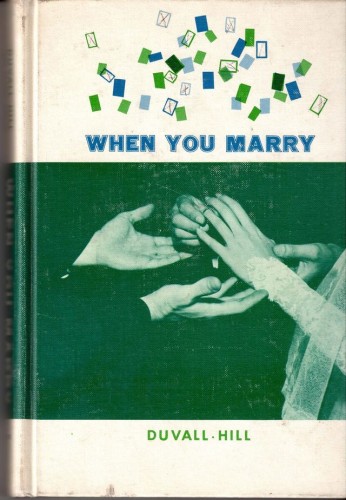
The book covers many aspects of dating and marriage and provides some fascinating insights into gender roles and social assumptions of the time. Here are some useful facts about social classes and families that you might like to know:
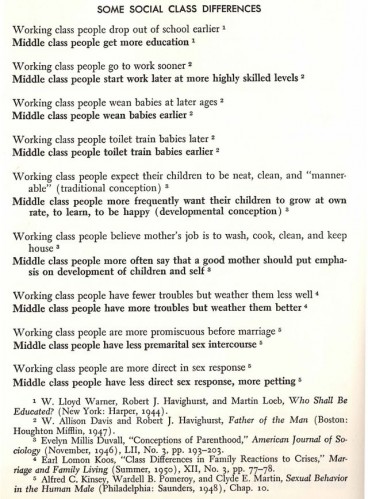
Working class people go to work sooner? Wow. Weird. But at least they have fewer troubles than the middle class. There are so many irritations you have to face when you aren’t poor, but at least you “weather” them well.
I may use this as an example of pointless graphs:
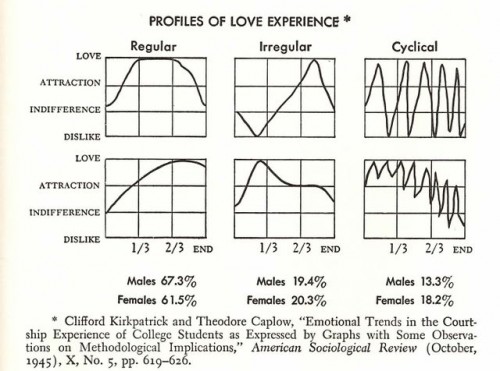
Here we have a list of some factors that are favorable, unfavorable, or unimportant for marital success; I’ve circled some of the more noteworthy items in red:
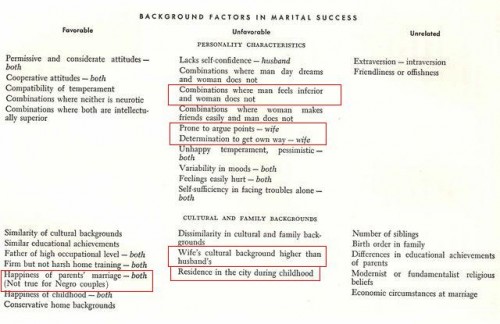
Text I highlighted:
[favorable]
Happiness of parents’ marriage —both (Not true for Negro couples)
[unfavorable]
Combinations where man feels inferior and woman does not
Prone to argue points–wife
Determination to get own way–wife
Wife’s cultural background higher than husband’s
Residence in the city during childhood
So you’re sure to have marital problems if the wife won’t give in on things and instead keeps being all argumentative and wanting her own way. I’m not sure what defines a cultural background as “higher” than others, but we see here the same pattern as we do with social class (which I presume is related to cultural background): it’s ok for men to “marry down,” but women aren’t supposed to.
The textbook provides a pretty grim depiction of sex for a newly-married couple:
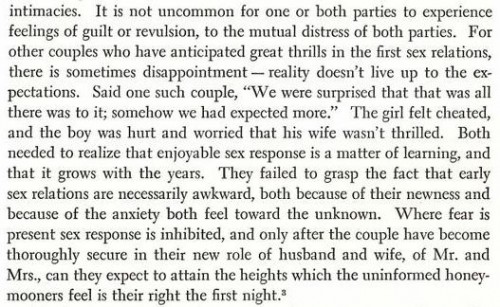
I found this little gem in on a page from the section on how ideals of marital life often don’t fit with reality:

It’s so widespread to think of marketing and advertising as manipulative today (even among those who like at least some ads or don’t see a real problem with them) that it’s striking to see such a sincerely positive portrayal of it as a helpful, even “kind” industry.
It is noteworthy that the textbook, used during the height of the “Leave it to Beaver” “traditional” family era, depicts the male-breadwinner/female-homemaker family form as a recent creation, as wives became “expensive luxuries”:
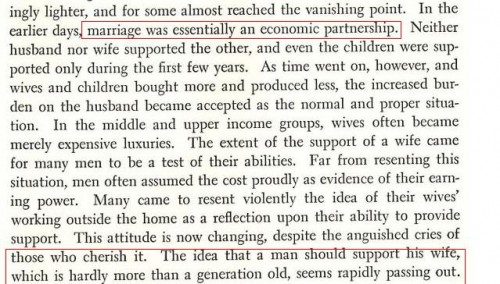
This section describing which women should work doesn’t seem to speak highly of women overall, since just a “few” of us have “special talents and skills.” However, it does make the point (in #5) that “a woman is not unemployed because she is not paid for her work,” an effort to bring attention to the value of women’s unpaid labor (in this instance, community/volunteer work):
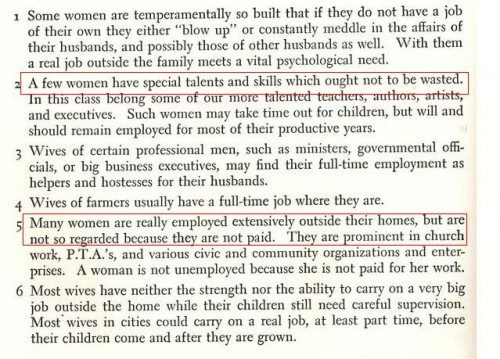
And then there is a helpful discussion of eugenics and good breeding :
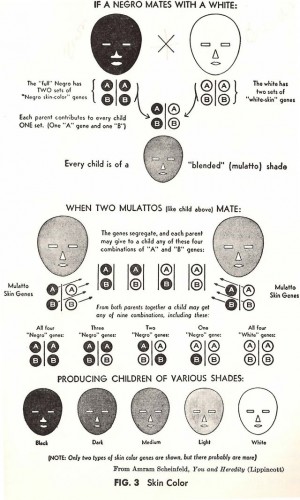
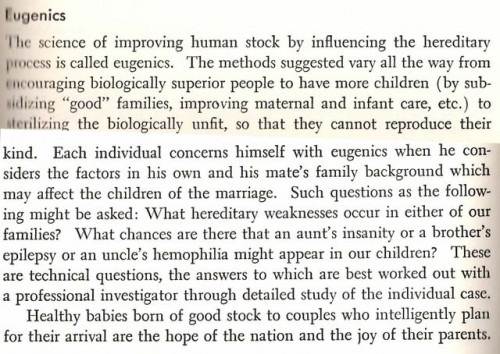
There’s a lot to ponder there. I think it’s fascinating the way that it illustrates some of our stereotypes about the 1950s/60s (women are supposed to be mothers, sex outside of marriage is bad, etc.) but contradicts others (the male-breadwinner family isn’t a long-standing “traditional” family but rather one they can clearly trace to the recent past, and which even then seemed like it might not last).
UDPATE: Larry looked through the pdf version of the whole book and found this nice cartoon:
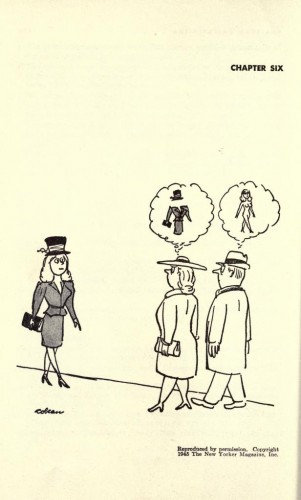

Comments 48
Jill — October 21, 2009
I think this is the most interesting SI post I have ever read.
Stephen Wilson — October 21, 2009
Does anyone know for what course or age this book was written? What an incredible find.
Stephen Wilson — October 21, 2009
Nevermind, background in link to referenced link to amalah.com.
Erik — October 21, 2009
I think it's amazing how quickly the father-breadwinner and stay-at-home-mom became cemented as THE American way, and the timeless ideal.
Perhaps the difference is that in the old days, and I'm just guessing here, the women were working but it was work in/around the home, so they could still take care of young children. Compared with today, where "work" almost always involves leaving the home and going to an office or shop or some place outside the home, necessitating day care, babysitters, and splitting the family up.
Maybe with the increasing work-from-home telecommuting that's occurring, we'll see somewhat of a return to a situation where both parents can work without having to rely on daycare or childcare services. I could imagine myself being a stay at home dad but doing some kind of independent work via a home-office. Like the comic Adam @ Home.
FrancoFile — October 21, 2009
@ Erik: I tried to resume work as a translator from home while my son was still tiny. Turns out he needed attention every waking moment (who knew!), and I couldn't rely on whether or how long he was going to nap so as to cram all my work into that window. I would stay up quite late at night to meet deadlines, which wasn't good for my health or mood. (I can imagine that if you have more than one child, they could play together, freeing you up for some work, but they might also fuss at each other.) In other words, it's a lovely idea, but in practice, very small children and brain-draining work don't mix. What if you hired some in-home child care to relieve you during work-intensive hours?
Chris Uggen — October 21, 2009
I believe that Minnesota Sociology's Reuben Hill had a hand in this one -- early fifties, perhaps? It was intended for high school students, I believe, and there's still a copy floating around the office.
Kelly — October 21, 2009
Wow. I actually have this book (purchased at a rural east Texas church thrift store) but have not delved into it yet. But now I shall!
Liz — October 21, 2009
The "kindness" of advertising seemed ironic to me--though of course I don't have the proper context. But it seems to be saying, in a roundabout way, that advertising IS a lie: "[w]ithout their aid we would never see such a pretty picture" means "what they show does not exist." Seems pretty negative to me, just a more subtle irony than we're used to these days.
abby — October 21, 2009
The bit about sex expectations didn't come off as unjustly negative to me. I think many who wait until marriage do probably did feel cheated. Two virgins are probably never a good time.
Alessandra — October 22, 2009
On the working/middle class differences, I found this really interesting:
-working class people have LESS problems, but weather them less well
-middle class people have MORE problems, but weather them better
Cola — October 22, 2009
The part about the heredity explains a scene in one of my favourite books that's always stuck out to me as rather baffling. It's called "Earth Abides" and it was written in the thirties. It was one of the first post-apocalyptic science fiction novels, taking place entirely after a virus has wiped out ninety-five percent of the world's human population. The main character is a white guy from San Francisco named Ish who survives and eventually meets a few other survivors and basically attempts to rebuild civilisation (with mixed results).
After exploring the dessicated countryside, he returns to his family home in SF and eventually meets a woman with whom he starts having children. Before they do this, though, she becomes very emotional and "confesses" to her mixed heritage, which is more implied than stated, mostly by the protagonist thinking to himself that, yes, her teeth did seem unusually white. And she is apparently guilty that she's going to be passing on her tainted genes, that some of their kids may be of darker complexion.
I always thought that was weird. The protagonist isn't bothered for a moment and tells her not to worry, but why the author ever went there baffled me until now.
Thank you Socio-images!
Jon — October 22, 2009
The interest in this is the mix of the absurd (suggesting black people are not affected by the state of their parents' marriage, or are even somehow negatively affected if their parents had a happy marriage?) and the frankly stated concepts that still have currency today. The point has already been made that there are only cosmetic differences between much of this and current self-help literature. The main difference is that it is now necessary to find metaphors (Venus and Mars) or euphemistic ways to make the same points. Right or wrong, and doubtless due to our status as partially-evolved, imperfectly-socialised human animals, it CAN cause friction when a wife (or wife-equivalent) is of a higher social status than her spouse, and the same is much less often the case when it is the husband who has a more upper-class background. And though kind of funny and clunky, and with the noted insult of the reference to "a few" women having special talents, the way that the issue of women balancing work and motherhood is approached is actually quite rational (for women who are, or who want to be, mothers). The same concerns could certainly be applied to men who take on the primary care-giver role. Even the discussion of Eugenics, though it makes your skin crawl, makes a couple of good points: of course it's important for couples to consider genetic weaknesses they may pass on (haemophilia, some mental ilnesses etc.) before having kids. It doesn't mean they should be subjected to compulsory sterilisation, it's just part of family planning. Don't forget that as well as forever dooming all study, or even mention, of Eugenics, the Nazis gave Darwinism a pretty thorough soiling too.
Laughing at this book, as with anything with a social opinion from the fifties, is enjoyable, but realising how little we've really changed is perhaps more constructive. Honestly facing the issues that hold the human race back from making best use of all its members is doubtless a better strategy than deciding that men and women are from different planets
Eneya — October 22, 2009
This is really interesting.
Especially when searching for the similarities and differences of today beliefs about working class and middle class.
Although I think that these particular names are out of date.
P.P.
Lisa, can I ask you something - how about chavettes?
Does this term exists in US?
Maria — October 22, 2009
The black/white "breeding chart" is of dubious science at the very least, but I wonder in what context it was given. It doesn't seem to discourage interracial marriage. I wonder what else they said about interracial marriage. And I wonder if the black and white tags signified only the skin color of the children so produced or if it also identified their Race.
John I — October 22, 2009
Wow. I have a marriage guide from the 1920's that is actually in some regards more progressive than this book seems to be. Someday I'll sac some pages.
Diesel Mcfadden — October 22, 2009
Don't make fun or feel superior too fast. There is no apex in relationship advice.
Our Marriage guidebooks will look just as provincial in 2050. :).
lowbrowculture » Blog Archive » Brain Dump – October 23rd — October 23, 2009
[...] “When you Marry” – they don’t write ‘em like that any more: It is not uncommon for one or both parties to experience feelings of guilt or revulsion, to the mutual distress of both parties. For other couples who have anticipated great thrills in the first sex relations, there is sometimes disappointment – reality doesn’t live up to expectations [...]
Friday Feminist Quick Clicks, 5 « Cook & Hook — October 23, 2009
[...] Vintage sexism. [...]
Ann — October 23, 2009
Did anyone else notice the difference in noses on the white and black face?
Cynthia — October 26, 2009
I kind of have issues with the reference that "women of color" worked and that the norm of a SAHM is a white thing. That may be the case in the west, but SAHMs were normal where non-whites were of "majority" as well. My parents are from Hong Kong and are Chinese (i.e. NOT WHITE). Both my grandmothers were SAHMs. It was just The Thing To Do for them and I'm pretty sure that none of their friends worked past getting pregnant either.
Just a thought. I have found that most boards are very west/North American-centric and don't think about what goes on in other countries. I do agree that the SAHM thing post-WWII is very middle and upper class though.
Football and history — August 4, 2010
Pelé - 1958, 1962, 1966, 1970 FIFA World Cup Classic Players...
Very interesting post, I've added a Trackback to it from my blog :)...
Football , Cricket, sports — August 5, 2010
Pelé – 1958, 1962, 1966, 1970 FIFA World Cup Classic Players...
Very interesting post, I've added a Trackback to it from my blog :)...
Kathleen — October 26, 2010
This is a minor point, but I think you should reconsider using those love graphs as examples of pointless graphs. Are they? I think they are more interesting (and actually, also, perhaps better at capturing something about reality) than most of the graphs we make these days...
Michael R. Brown — December 30, 2010
The blogger/commenter here is snarky and annoying. Some folks find infinite depths of outrage and/or amusement at how increddddibly iggnorrant the 50s/early 60s were. Yeah, we know. It's been ground away at for about 40 years. It's worse and less than a cliche. I prefer to see things more contextually, while recognizing groping ignorance (or worse) of the time.
Aaron — January 16, 2011
Is what we are doing with our marriages today working? Isn't what 90% of what this book says accurate? Sure, it's creepy. But that's because we send our children out into the dating world with very little advice.
It says women should never marry down. Sure, it sounds bad but women NEVER do.
Sunshine — March 12, 2011
The paragraph about first intimacy is an argument in favor of premarital sex. The awkwardness and guilt involved sounds like it should be worked out before marriage. Marriage is difficult enough to adjust to without having to worry about learning the basic mechanics of sex.
NOTE: I am not in favor of anyone having sex before they are mature enough to use birth control correctly and consistently. Young teenagers should be focused on school, not sex.
Pauline — May 21, 2011
I've been leaving through this book, and I think it's actually quite good for its time.
The part that I found really funny was where they discuss whether you can still date other people or not if you are engaged (and the answer wasn't completely negative!); I don't think that's something that's considered acceptable nowadays, except for polyamorists.
Very interesting was a chapter called "Does morality make sense?"; it's about premarital sex and I found it was not nearly as bad as it sounds.
It says that premarital sex is a problem precisely because society says so, and that because this is the societal norm, people who have premarital sex will generally feel guilty and ostracised.
This chapter also discusses the reasons there could be behind the idea of exclusive sex with only one person; the conclusion is that if you have random sex with anyone you'd like to, you'd have to shield yourself from getting emotionally attached to the people you have sex with, to prevent jealousy and broken hearts (which actually is the attitude adopted by a promiscuous guy I know). In the opinion of the writers of the book, sex is not worth that.
Anyways, IMO, this book is quite good, especially given its time. Most of the time, the writers seem open and non-judgemental, simply trying to give the advice which they think will benefit their readers the most.
Carrie — June 6, 2011
I lol'd.
Blix — July 9, 2011
That first part makes me think that they did absolutely no research at all. It almost sounds like the start of ethnic cleansing, only class cleansing.
James Franko — August 27, 2021
My friend recently realized that she liked girls and did not know where to find relationships for herself. There were a lot of cool girls on the site cupid.com, ready to chat. A friend very quickly found a mate and is happy in a relationship, I advise you to visit this site, there you can make cool acquaintances.